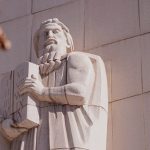
An Abundance of Caution: American Schools, the Virus, and a Story of Bad Decisions, by David Zweig (MIT Press, 464 pp., $39.95)
In the early spring of 2020, freelance writer David Zweig was, like most suburban dads, willing to follow the advice of experts. “People were dying from a scary new disease, and my family and my neighbors were readily compliant with the governor’s orders to stay home and stay apart from each other,” he writes in his new book, An Abundance of Caution: American Schools, the Virus, and a Story of Bad Decisions. As a member of the “laptop class,” and living in a charming Hudson Valley village, Zweig knew that he and his family were among the luckiest cohort of Americans when it came to weathering the Covid-19 pandemic.
Still, something didn’t feel right. Zweig watched his two elementary-school-age children “slowly wilting in the gray light of their school-issued Chromebooks.” How long would they be cut off from the touch of a playmate or face-to-face contact with a teacher? Concerned and curious, Zweig set aside a book he was working on and began calling experts and asking questions. Did closing schools really slow the progress of the virus? Why did all U.S. schools shut down in a single week in March, even in regions with virtually no Covid cases? What science supported the CDC’s heartless recommendation that even two-year-olds in day care must wear masks?
Finally, a reason to check your email.
Sign up for our free newsletter today.
The deeper Zweig dug, the more his sense of astonishment—and then of outrage—grew. As early as March 2020, it was clear that Covid, unlike influenza, posed little threat to children. Nor were schools major centers of virus transmission, studies showed. In other words, the scientific evidence supporting long-term school shutdowns was weak, the author discovered, while the policy’s negative impacts were potentially devastating.
Zweig pitched his editors at the New York Times: How about an article detailing the scientific case for reopening schools? They weren’t interested. Nor were several other outlets he had worked with. Eventually, the article ran in the tech magazine Wired. The piece had little impact on the national debate over school closures, not because it wasn’t persuasive but because there was no national debate over school closures.
As in other elite communities, Zweig’s neighbors posted “In this House We Believe” signs in their yards stating, “Science Is Real.” Government officials, including New York governor Andrew Cuomo, relentlessly insisted that their policies were based on “data.” But when Zweig and a handful of other researchers convincingly challenged the scientific case for school closings, the blue-state voters and policymakers took little notice. The media, which normally prides itself on curiosity and skepticism, refused to question the overnight consensus. “The narrative was set,” Zweig writes.
In contrast, European policymakers took the research involving Covid and children seriously. By May, most European countries were beginning to reopen their schools. Liberal Americans usually think European nations are more enlightened on issues of social policy. But U.S. media and public health leaders mostly ignored the European example. When pressed, they waved away the disparity, insisting that European countries had “controlled” the virus prior to reopening schools, unlike the U.S. under the erratic President Trump. It wasn’t true, but it fit the narrative. American schools stayed closed.
Most U.S. schoolchildren wouldn’t return to full-time, in-person school for more than a year. That interregnum, we now know, seriously degraded their social development, educational attainment, and mental and physical health. All too predictably, disadvantaged children suffered the worst declines.
You’d think these facts would have put liberal America in an uproar. Yet, even today, this policy disaster rarely comes up in those circles. When it does, Zweig writes, “Many on the left argue that the prolonged school closures were a fog-of-war decision made on the best available information at the time.” That’s a comforting claim. But, again, it’s simply not true, he argues. The best available information at the start of the pandemic militated against prolonged school closures. The evidence supporting that conclusion only grew stronger as the months went by. So, Zweig wants to know, “What led the U.S. to be if not uniquely, then certainly exceptionally dysfunctional?”
Five years on, Zweig’s meticulous account is finally igniting the debate that should have taken place in 2020 and 2021. His book has two main aims. The first is to document the science behind Covid transmission and school closures. He does this with dogged reporting and lucid writing. The evidence for masking, the epidemiological support for the “six-feet-apart” rule, the argument that children put teachers at undue risk—all those claims were founded mostly on unquestioned assumptions or sloppy studies, Zweig shows. The virus transmission models used to justify shutting down American society often turn out to have been based on little more than hunches. For example, a federal pandemic-preparedness guide included a recommendation to close schools (briefly) on the premise that children and teens interact more closely—and thus spread viruses more readily—than adults. That pivotal assumption came partly from a school project produced by the 14-year-old daughter of a pandemic modeler, Zweig discovers.
Zweig’s second aim is more difficult: to explore why American institutions, from the federal government to the media to local school officials, all lined up behind a disastrous and scientifically unfounded policy—and stayed that way for so long.
Zweig is especially interested in how the media reinforced alarmist narratives and sidestepped any information that challenged their doomsday slant. He takes particular aim at the New York Times, both because that paper sets the agenda for much of the legacy media and because its Covid reporting was so bad. In May 2020, for example, the paper’s lead Covid reporter, Apoorva Mandavilli, wrote a piece titled, “New Studies Add to Evidence that Children May Transmit the Coronavirus,” which argued that cases could “soar” if schools reopened. The first study Mandavilli cited was not actually a study at all, but rather a public-health modeling exercise based on assumptions about Covid transmission. (Zweig uncovers numerous cases in which reporters and public-health officials gave more weight to models predicting how the virus might behave than to real-world data showing how the virus was behaving.)
Mandavilli’s piece also relied on an unpublished study showing that children infected with Covid carry high viral loads, which would imply they are highly contagious. That claim turned out to be false, and the study was later revised to reach the opposite conclusion. But the damage had been done. Mandavilli’s penchant for cherry-picking dubious reports that supported her preconceptions, while ignoring research that didn’t, would remain a pattern throughout the pandemic. (Readers might recall how, in 2021, Mandavilli tweeted her hope that people would “stop talking about the lab leak theory and maybe even admit its racist roots.”)
For the next year and more, most public health leaders and media outlets would stay in lockstep over their embrace of school closures and dismissal of the lab-leak hypothesis. The latter issue is not Zweig’s focus. (Matt Ridley and Alina Chan’s book Viral provides a good overview.) But it is striking how, in both cases, the media, public officials, and even esteemed scientists leaned into a consensus based not on scientific data but on political tribalism.
The big X-Factor in all this, of course, was President Trump. For the media and public-health establishment, Trump and his fellow Republicans were assumed to be ignorant, anti-science blowhards. Whenever Trump and his allies took a position (or simply asked a question), all right-thinking people had to line up on the opposite side.
Nonetheless, by the summer of 2020, more advocates for in-person schooling were speaking up. The American Academy of Pediatrics (AAP) advised reopening schools in the coming school year, and a few states began planning to do so. Then, on July 6, Trump tweeted, “SCHOOLS MUST OPEN IN THE FALL!!!” Overnight, the tentative push to bring children back to classrooms “immediately met an indomitable headwind,” Zweig writes. The AAP reversed course and issued new guidance arguing for prolonging school closures. Public-health officials and blue-state political leaders virtually all went along. To do otherwise “would mean being out of step with their political tribe,” the author observes.
This tribalism cut two ways. Zweig continued to publish articles challenging the Covid consensus and began lobbying his local school officials to reopen classrooms. He recalls two health professionals privately warning him that his work might empower the “Trumpers.” He wasn’t wrong on the facts, they told him, “but I was helping the wrong people.” It wasn’t enough to adhere to the groupthink of one’s own tribe, apparently—one must also avoid discussing data that might bolster views held by the “wrong” tribe.
Bizarrely, this Covid omertà only got worse after Trump left office. Health officials from Anthony Fauci on down grew even more dishonest and intransigent. Rochelle Walensky, who became director of the CDC after Joe Biden took office, repeatedly claimed that schools without mask mandates were “three and a half times more likely to have outbreaks” than schools where students were masked. When Zweig read the CDC-published paper making this claim, however, he discovered “absurd” errors in methodology. Even one of the study’s authors admitted to him that some of the paper’s numbers were wrong. But Walensky kept repeating the bogus statistic. And, when Zweig asked the CDC about the issue, a spokesperson denied there were any problems with the paper. “It was pure gaslighting,” he writes, “like something I’d imagine out of a corrupt regime behind the Iron Curtain.”
It’s a depressing story and a maddening one. Unlike many books on public policy, An Abundance of Caution does not include a handy list of bullet-point solutions to the problem. Instead, the author focuses on helping readers understand that there was a problem—something many journalists and policymakers still don’t concede.
At times, Zweig goes into more meticulous detail than the general reader might feel is necessary. But can you blame him? He spent years investigating a national scandal that America’s top health officials, science journalists, and media outlets didn’t seem to notice, even though he could see its impact on his own family and town. One can imagine Zweig thinking: If I don’t document these terrible failures of science and leadership, no one else will bother. It will all be forgotten.
The tragedy of this country’s pandemic school closures should not be forgotten. Thanks to Zweig’s remarkable book, it won’t be.
Photo by Irfan Khan / Los Angeles Times via Getty Images
Source link


















